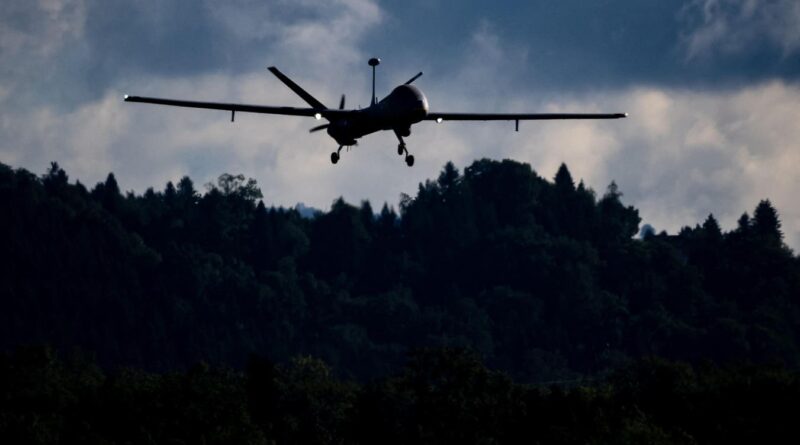Saudi Arabia And The UAE Are Acquiring Lots Of High-Tech Drones
One of the first two Hermes 900 HFE reconnaissance drones is seen in silhouette during certificate flights at Emmen Air Base, central Switzerland, on September 8, 2022. (Photo by FABRICE COFFRINI/AFP via Getty Images)
AFP via Getty Images
Saudi Arabia and the United Arab Emirates have accelerated their respective buildups of advanced military drones sourced from various countries. Not merely content with buying such drones off the shelf, Riyadh and Abu Dhabi are also securing significant technology transfers and localized production agreements.
The UAE’s EDGE Group defense conglomerate is reportedly in negotiations with Israel’s Elbit Systems defense contractor on a deal for the latter’s Hermes 900 drones.
Built for surveillance and reconnaissance and outfitted with advanced sensors and a synthetic-aperture radar, the Hermes 900 has an endurance of at least 30 hours and a maximum flying altitude of 30,000 feet.
Abu Dhabi wants the technology and licensing required to manufacture more of these surveillance aircraft on Emirati soil.
“A central aspect of the Israeli-UAE Hermes 900 agreement is that alongside the purchase of an undisclosed number of drones, it encompasses a phased technology transfer plan leading to eventual domestic production by an EDGE subsidiary,” noted a recent analysis by the Washington Institute.
“The Hermes blueprint thus could allow the UAE to transform itself from importer to manufacturer—which would realize a critical component of its 2025-28 strategic plan to strengthen its defense sector.”
The purported deal is merely the latest in a long line of deals either under discussion or underway between the UAE, Saudi Arabia, and the world’s leading drone manufacturers.
In 2022, reports emerged that the UAE received 20 of Turkey’s widely exported Bayraktar TB2 armed drones. The deliveries followed reports that Abu Dhabi entered negotiations for an acquisition of as many as 120 TB2s as part of a $2 billion deal and had offered to build a TB2 drone factory on its territory.
Turkish President Recep Tayyip Erdogan visited Saudi Arabia in July 2023, where he secured a record-breaking arms deal. The kingdom signed a contract with Turkey’s Baykar Defense, manufacturer of the popular TB2 drones, for its large and advanced twin-engine Akinci combat drone. While the specifics of the deal, including its overall value, weren’t disclosed, the CEO of Baykar nevertheless described it as “the biggest defense and aviation export contract in the history of the Republic of Turkey.”
As with the UAE, Saudi Arabia is increasingly interested in securing technology transfers and localized production agreements with these landmark arms deals in accordance with its Vision 2030 reform agenda. Consequently, we may see Saudi factories churning out Akinci drones in the future.
Baykar began 2025 by announcing it had delivered two Akincis to the UAE as part of a hitherto undisclosed deal. It’s unclear whether Abu Dhabi has reached agreements with Baykar for the localized production of either the TB2 or Akinci. Nevertheless, EDGE has already cooperated with Baykar, notably on a project for integrating its Desert Sting smart micro munition with the Bayraktar TB2.
As part of the package of potential arms deals valued up to $142 billion announced during President Donald Trump’s May visit to Saudi Arabia, General Atomics announced talks for selling Riyadh up to 200 MQ-9 Reaper drones.
While talks are in their early stages and Riyadh might not ultimately acquire that number, especially if it does not include a localized production agreement, mere discussion of such a sale would have been almost unthinkable less than a decade ago.
Perhaps many of these deals would have been nearly inconceivable a decade ago.
For one, the UAE hadn’t yet established diplomatic relations with Israel under the 2020 Abraham Accords. Furthermore, Abu Dhabi and Riyadh were at odds with Turkey and on opposing sides of numerous proxy conflicts spanning several flashpoint regions. And the United States refused the export of any of its armed drones to the Arab Gulf states, primarily due to its strict adherence to limitations recommended by the Missile Technology Control Regime, which it recently reinterpreted.
While America did sell the UAE MQ-1 Predator drones in the 2010s, they were the Predator XP variant, specifically designed not to carry any munitions. Washington declined Emirati requests for Reaper drones until the Abraham Accords, when the Trump administration approved a landmark deal to sell Abu Dhabi 50 fifth-generation F-35 Lightning II stealth strike fighters and 18 Reaper drones. However, the UAE later suspended that deal in December 2021 out of frustration over American preconditions.
It’s unclear whether the UAE might renegotiate a deal for Reapers in the near future, especially in light of the substantial numbers of these advanced drones destroyed in recent U.S. air campaigns against the Houthis in Yemen. In the last U.S. air campaign against the group, the March-April Operaiton Rough Rider, the Houthis shot down seven U.S. Reaper droneswhich cost approximately $30 million each, in six weeks. Since they both fought the Houthis in the recent past, Riyadh and Abu Dhabi doubtlessly took note of those losses.
The Gulf states found other sources for their military drones in the 2010s. At that time, China briefly capitalized on Washington’s refusal to export certain drones by widely exporting its armed Wing Loong drones to several regional states, including the two neighboring Arab Gulf states. Abu Dhabi and Riyadh acquired a few dozen armed Wing Loong II drones, built by Beijing’s state-owned Chengdu Aircraft Industry Group, in the second half of the 2010s. Saudi Arabia has also obtained licenses for building Chinese-designed drones locally.
Ahead of that record-breaking 2023 Akinci deal, Saudi Arabia reached an agreement with Turkey for producing its armed Karayel-SU under license in the kingdom.
All these deals illustrate how Saudi Arabia and the UAE’s grand plans for expanding and enhancing their military arsenals with significant numbers of sophisticated drones are underway and could have substantial ramifications for present and future conflicts in their volatile region and possibly beyond.




